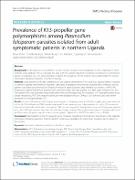Prevalence of K13-propeller gene polymorphisms among Plasmodium falciparum parasites isolated from adult symptomatic patients in northern Uganda
| dc.contributor.author | Ocan, Moses | |
| dc.contributor.author | Bwanga, Freddie | |
| dc.contributor.author | Okeng, Alfred | |
| dc.contributor.author | Katabazi, Fred | |
| dc.contributor.author | Kigozi, Edgar | |
| dc.contributor.author | Kyobe, Samuel | |
| dc.contributor.author | Ogwal-Okeng, Jasper | |
| dc.contributor.author | Obua, Celestino | |
| dc.date.accessioned | 2019-10-29T17:54:37Z | |
| dc.date.available | 2019-10-29T17:54:37Z | |
| dc.date.issued | 2016 | |
| dc.identifier.citation | Ocan, M., Bwanga, F., Okeng, A., Katabazi, F., Kigozi, E., Kyobe, S., ... & Obua, C. (2016). Prevalence of K13-propeller gene polymorphisms among Plasmodium falciparum parasites isolated from adult symptomatic patients in northern Uganda. BMC infectious diseases, 16(1), 428. | en_US |
| dc.identifier.uri | https://hdl.handle.net/123456789/73 | |
| dc.description.abstract | Background: In the absence of an effective vaccine, malaria treatment and eradication is still a challenge in most endemic areas globally. This is especially the case with the current reported emergence of resistance to artemisinin agents in Southeast Asia. This study therefore explored the prevalence of K13-propeller gene polymorphisms among Plasmodium falciparum parasites in northern Uganda. Methods: Adult patients (≥18 years) presenting to out-patients department of Lira and Gulu regional referral hospitals in northern Uganda were randomly recruited. Laboratory investigation for presence of plasmodium infection among patients was done using Plasmodium falciparum exclusive rapid diagnostic test, histidine rich protein-2 (HRP2) (Pf). Finger prick capillary blood from patients with a positive malaria test was spotted on a filter paper Whatman no. 903. The parasite DNA was extracted using chelex resin method and sequenced for mutations in K13-propeller gene using Sanger sequencing. PCR DNA sequence products were analyzed using in DNAsp 5.10.01software, data was further processed in Excel spreadsheet 2007. Results: A total of 60 parasite DNA samples were sequenced. Polymorphisms in the K13-propeller gene were detected in four (4) of the 60 parasite DNA samples sequenced. A non-synonymous polymorphism at codon 533 previously detected in Cambodia was found in the parasite DNA samples analyzed. Polymorphisms at codon 522 (non-synonymous) and codon 509 (synonymous) were also found in the samples analyzed. The study found evidence of positive selection in the Plasmodium falciparum population in northern Uganda (Tajima’s D=−1.83205; Fu and Li’s D=−1.82458). Conclusions: Polymorphism in the K13-propeller gene previously reported in Cambodia has been found in the Ugandan Plasmodium falciparum parasites. There is need for continuous surveillance for artemisinin resistance gene markers in the country. | en_US |
| dc.language.iso | en | en_US |
| dc.publisher | BioMed Central | en_US |
| dc.subject | Artemisinin | en_US |
| dc.subject | Resistance | en_US |
| dc.subject | Medicines | en_US |
| dc.subject | Northern Uganda | en_US |
| dc.subject | Uganda | en_US |
| dc.subject | Plasmodium falciparum parasites | en_US |
| dc.subject | K13-propeller gene polymorphisms | en_US |
| dc.title | Prevalence of K13-propeller gene polymorphisms among Plasmodium falciparum parasites isolated from adult symptomatic patients in northern Uganda | en_US |
| dc.type | Article | en_US |
Files in this item
This item appears in the following Collection(s)
-
Research Articles [41]

